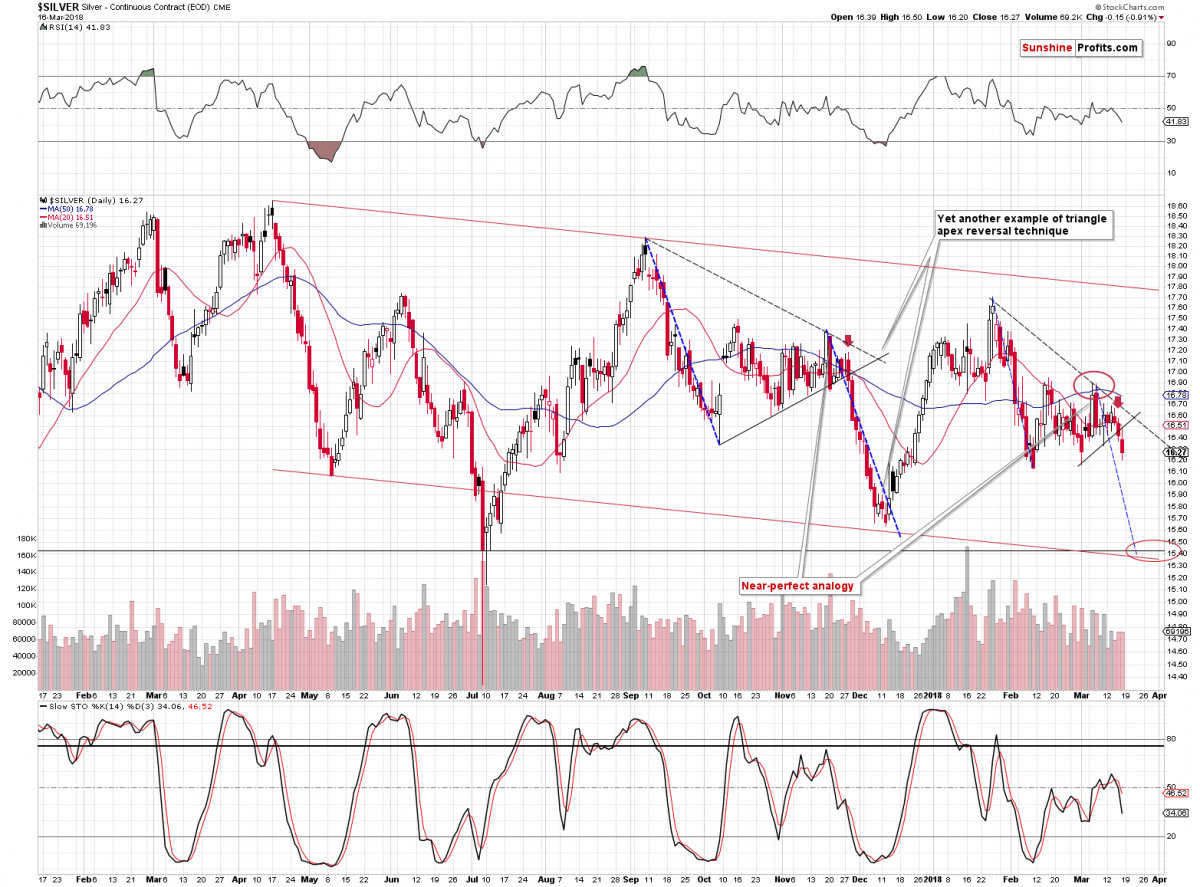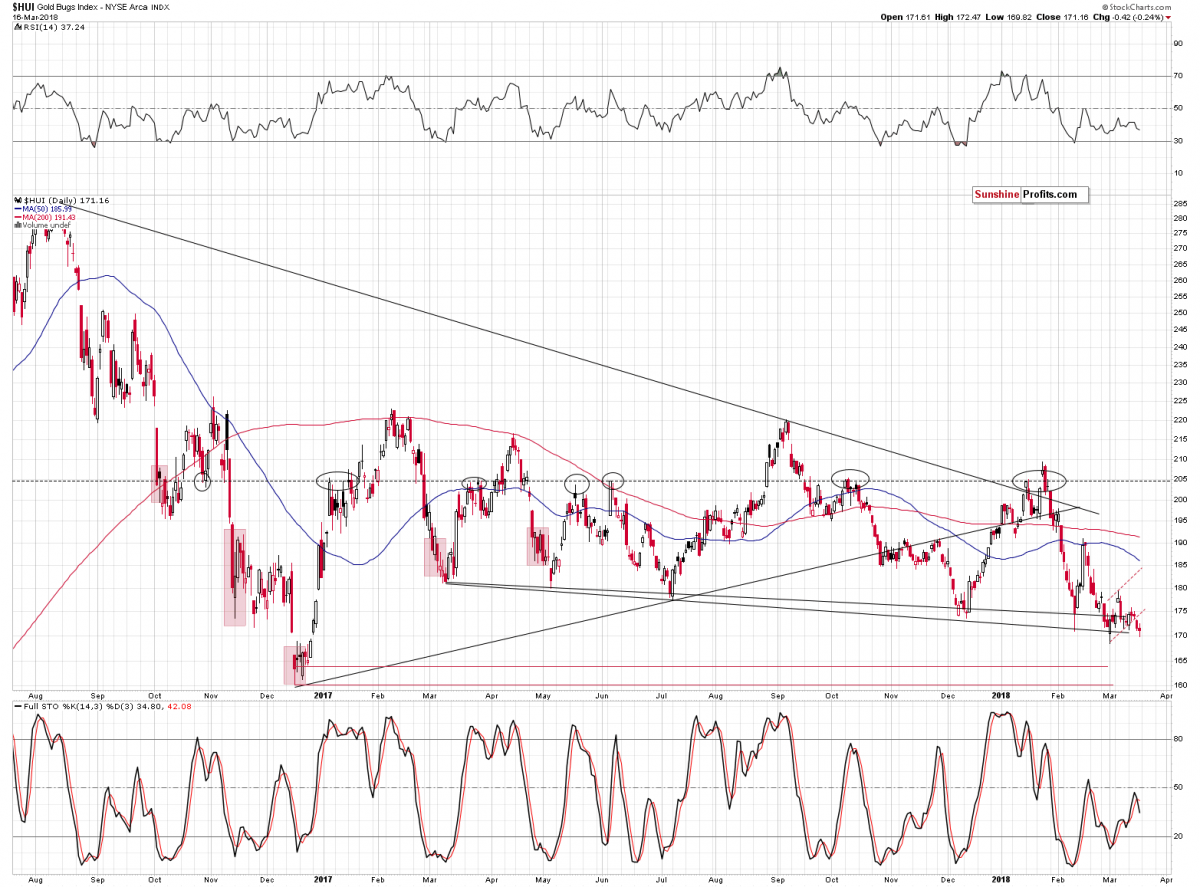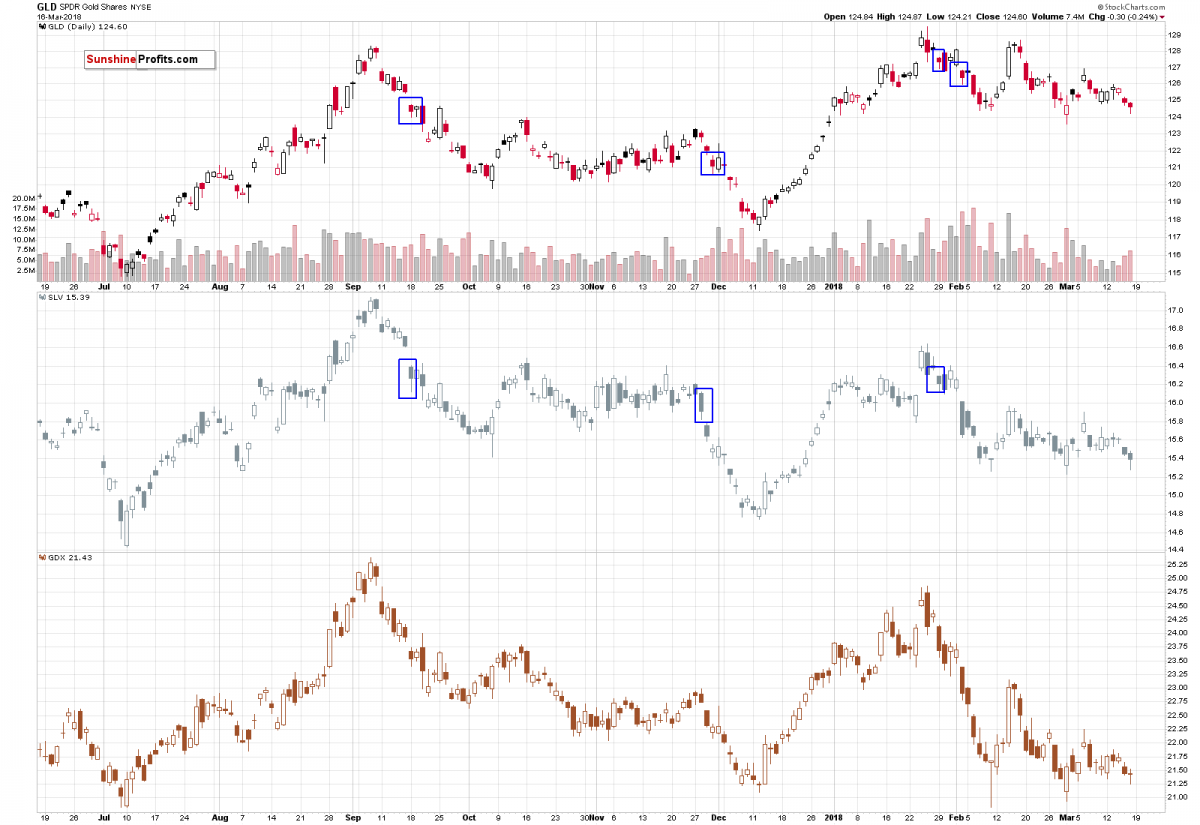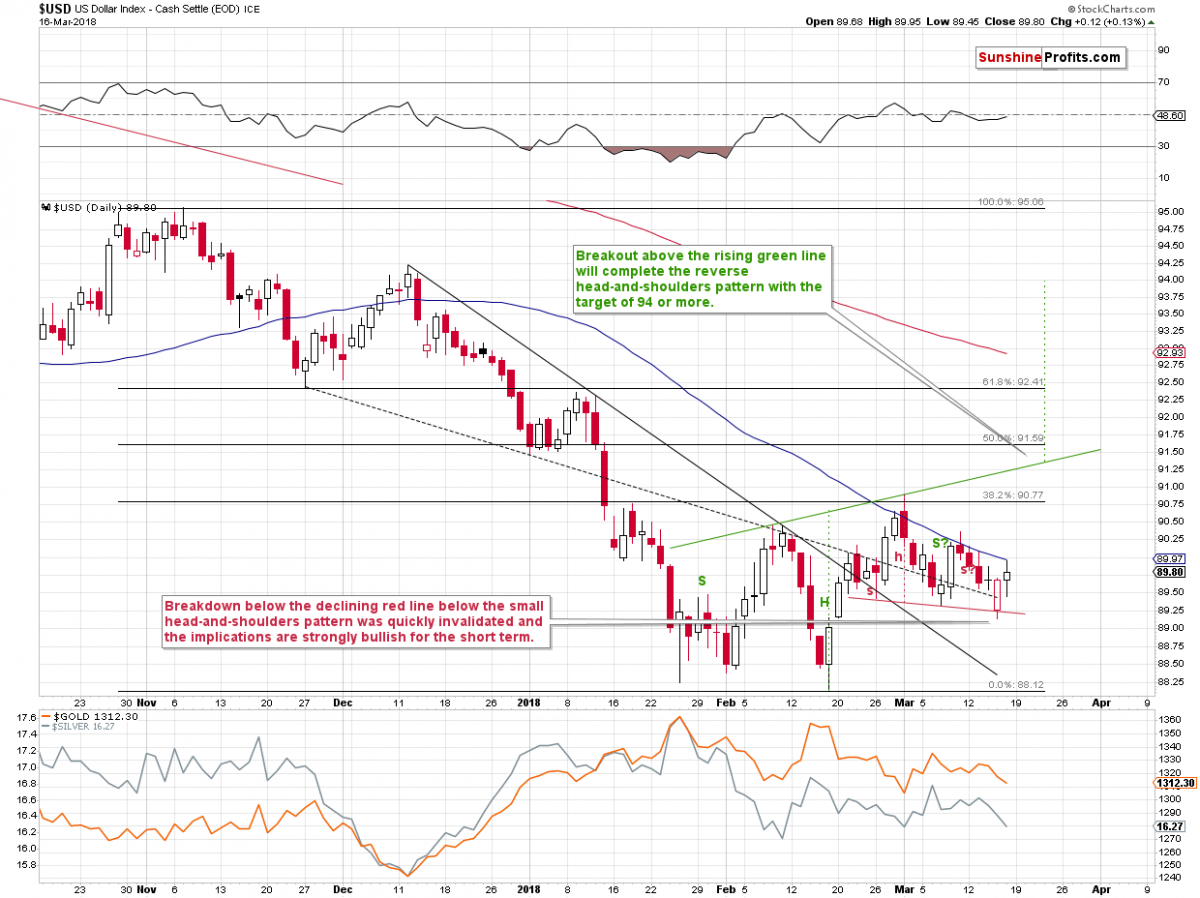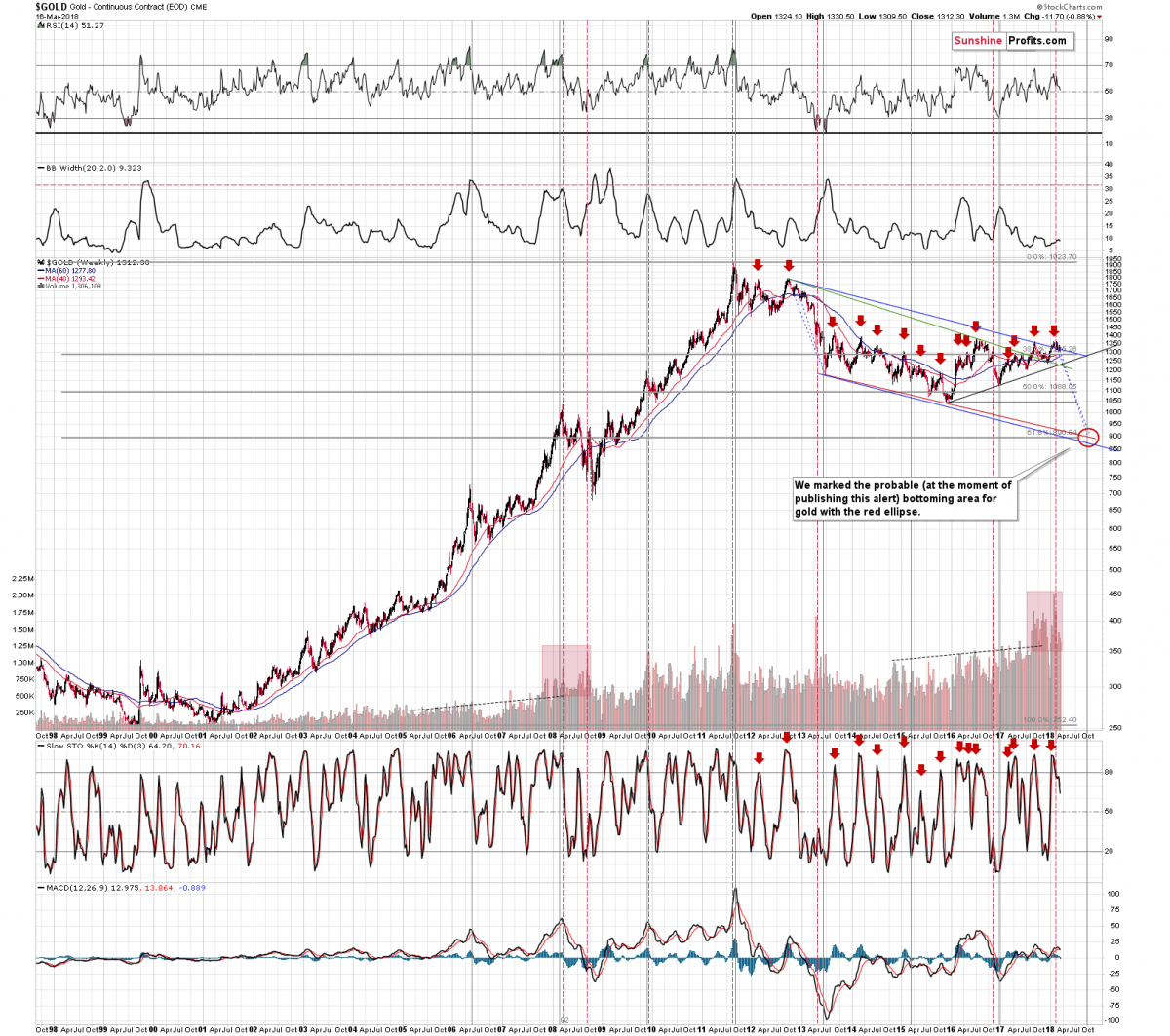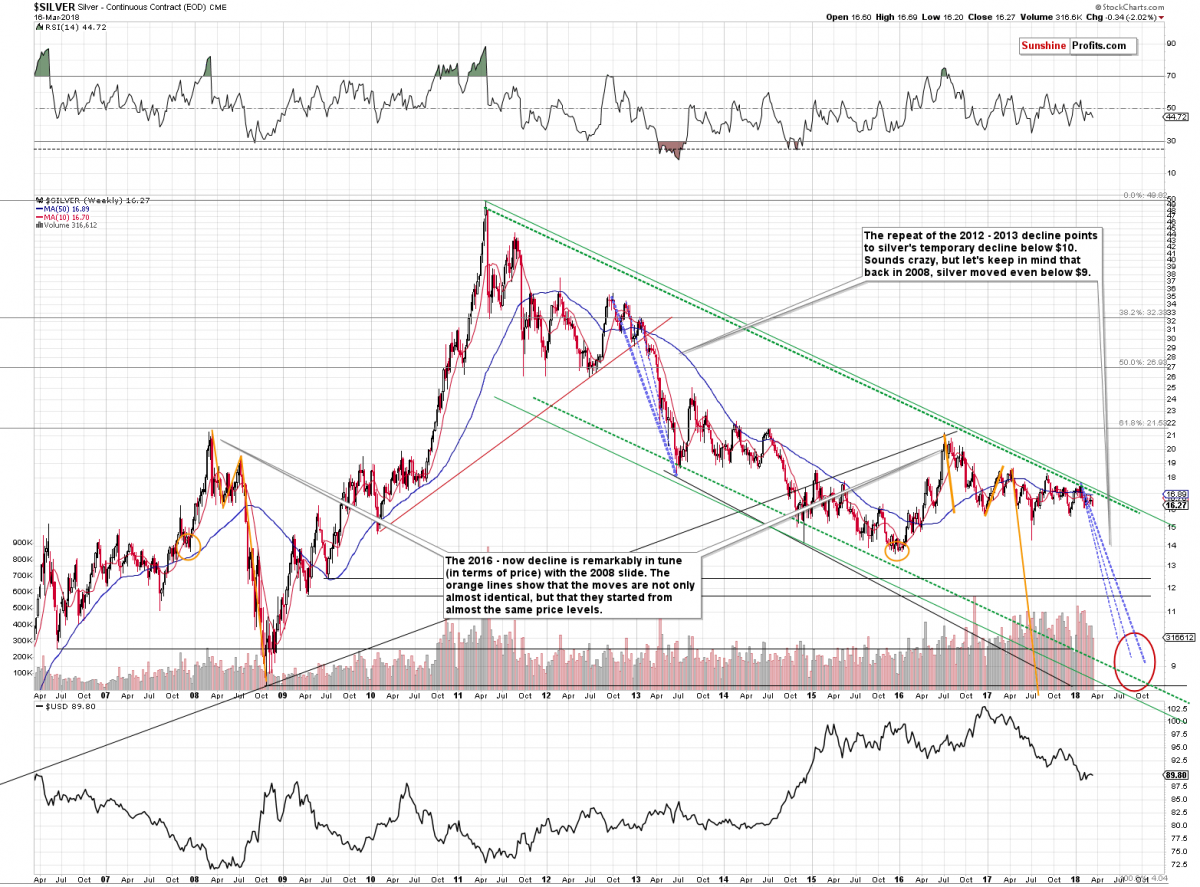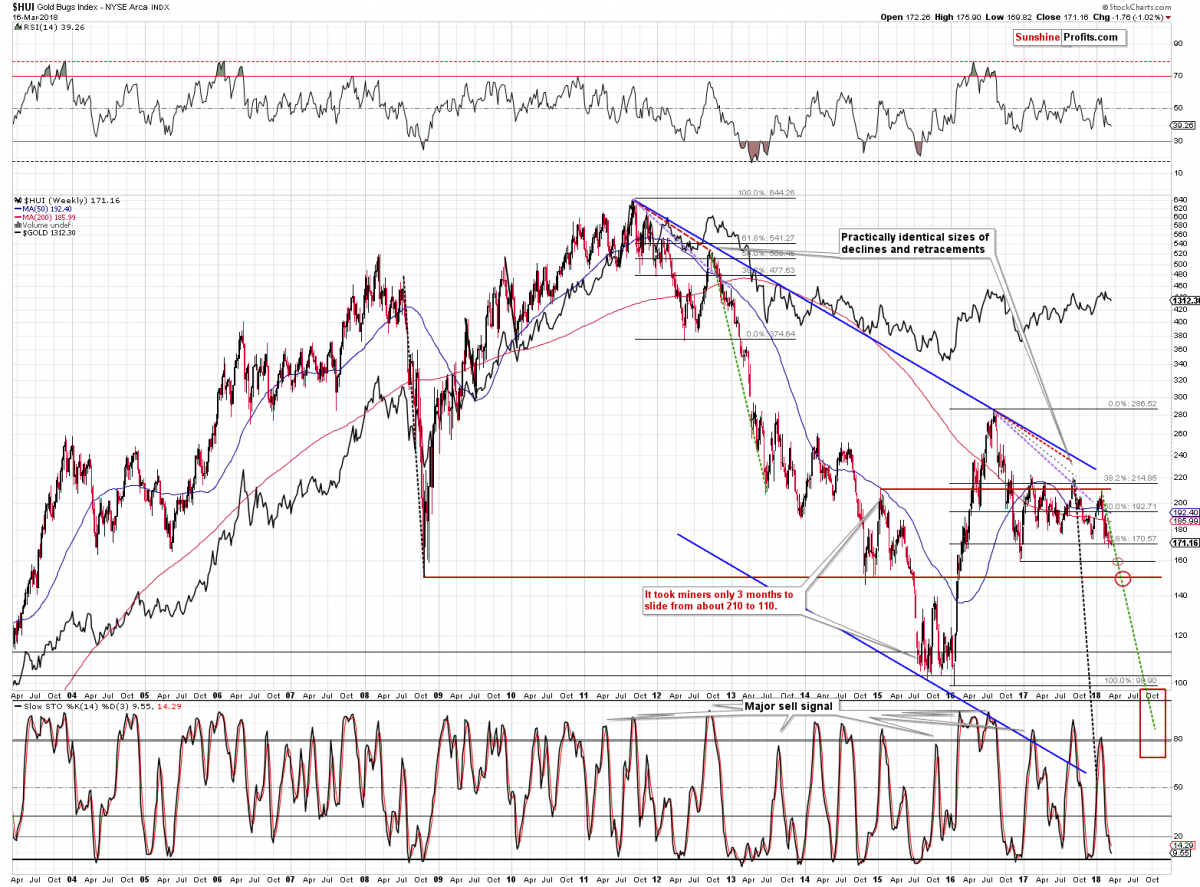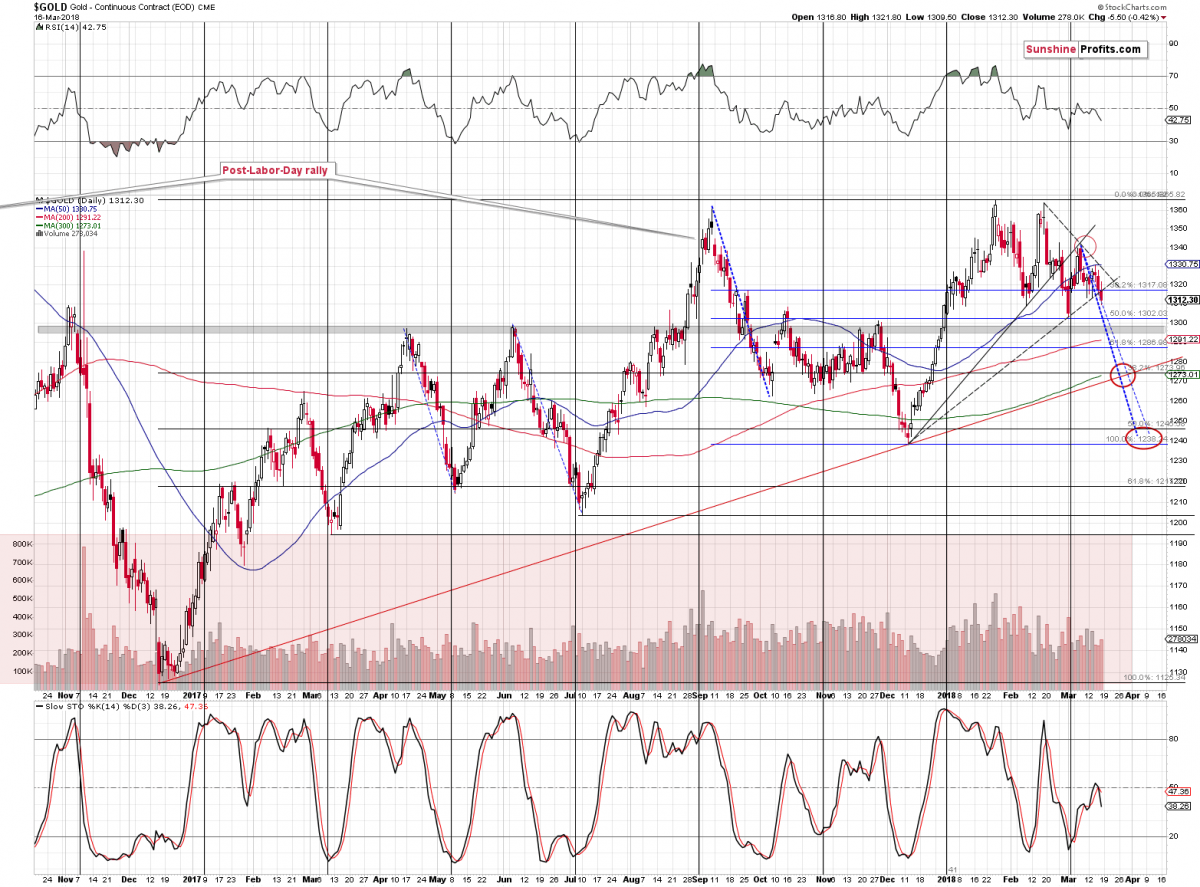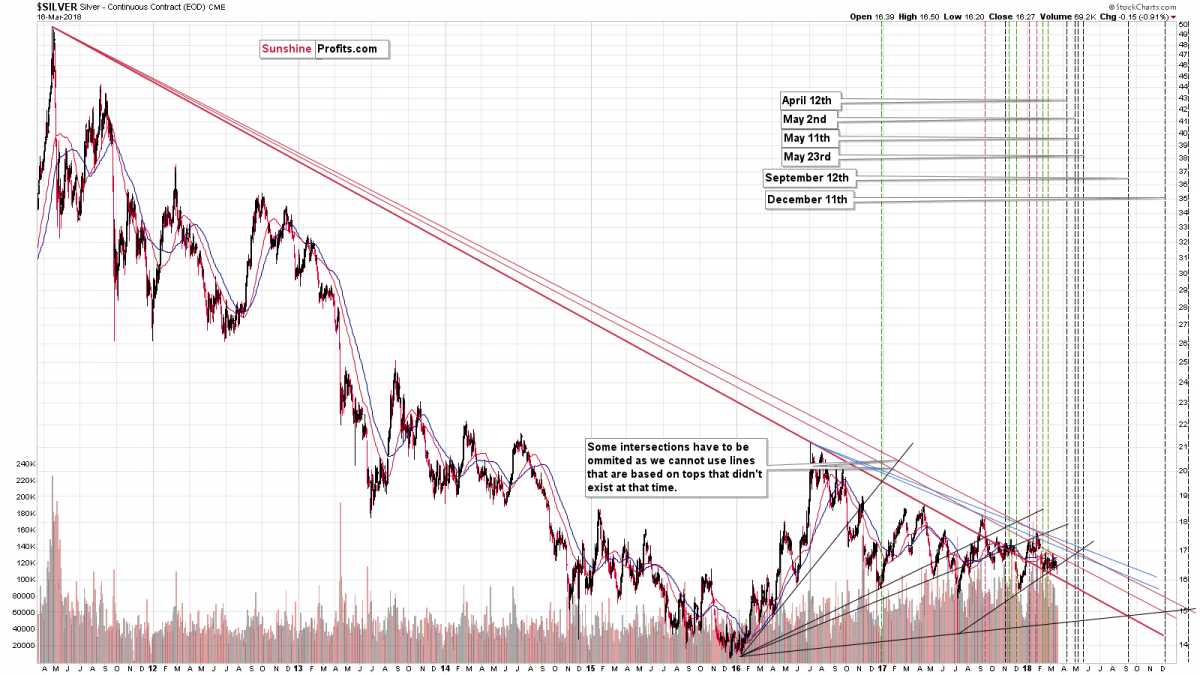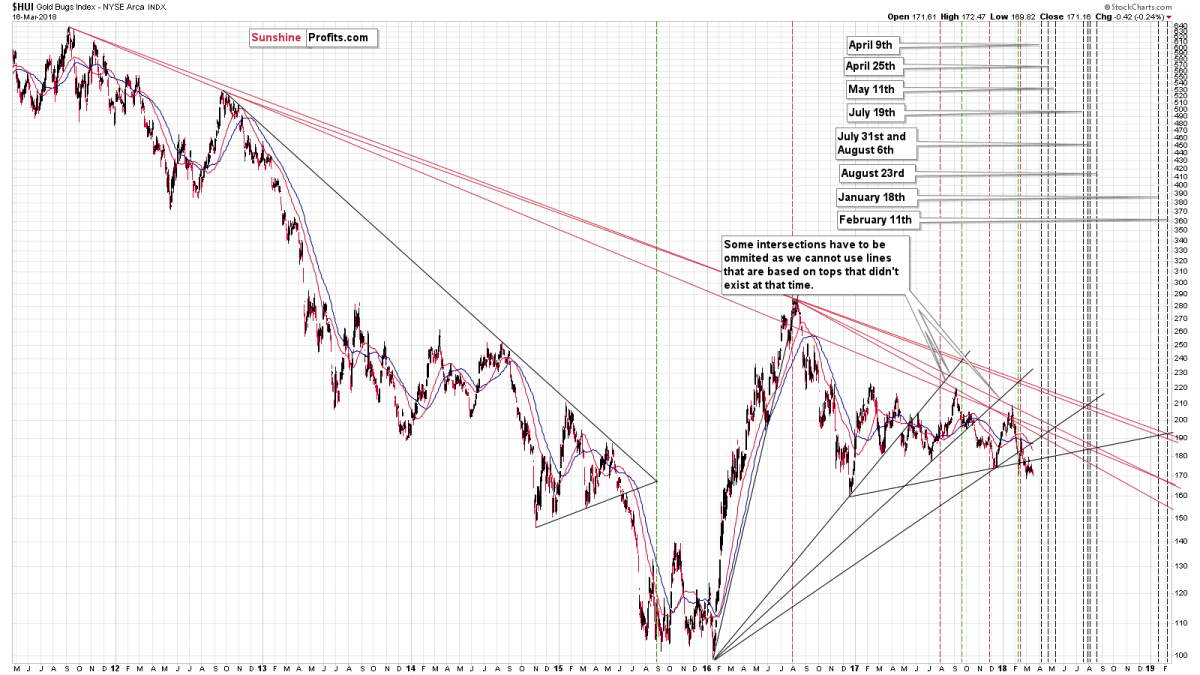2018 Reversal Dates For Gold, Silver And Gold Stocks
Friday’s session in the precious metals sector was very exciting, but quite a few investors will want to agree to that, because the volatility wasn’t really big. But the dam is broken, and we saw several new cracks pointing to an incoming breakdown. It’s not the time to look away from all the signs – it’s time to take advantage of them.
In addition to showing you how we plan to proceed with the above, we’ll discuss something much bigger – the dates at which gold, silver and gold miners are likely to reverse during the course of the year based on the technique that proves to be extremely useful over and over again.
We’ll start with the former.
Let’s see what happened in the gold market (charts courtesy of http://stockcharts.com).
Gold’s Downside Targets
One crack in the precious metals dam can be seen in gold. The yellow metal declined and closed the week below the rising dashed support line. The breakdown took place on volume that was a bit higher than what we saw on Thursday and Wednesday, which is a bearish confirmation. Naturally, the breakdown is not fully confirmed yet as there have been no three consecutive closes below the support line, but a weekly close and an increase in volume during the breakdown are already making it an important bearish sign.
The visible sell signal from the Stochastic indicator serves as another bearish sign.
The key thing that we can see on the above chart that has implications for the following days is the short-term triangle with the apex pointing to this week, which could indicate the time for a short-term reversal. It’s very good that approximately the same date can be seen for both the golden and silver triangles (see below) as it means that they confirm each other, and the entire prediction becomes more likely to become reality.
In the case of gold, we don’t have a medium-term self-similar pattern like the one in silver, so we assume that the current short-term decline is going to be similar to the previous short-term declines. We marked the most recent decline with a thick blue dashed line and the less recent smaller declines with thin blue dashed lines.
Other tools that we applied are the short-term Fibonacci retracements and the rising medium-term support line that we marked in red. The short-term Fibonacci retracements seem too close to the current price levels to trigger even a short-term rally at this time. Don’t get us wrong – this technique is very useful, but the key thing is that the retracements seem to have already worked and triggered a 1.5 month pause. After such a long pause, during which gold gathered strength for the next move, it seems unlikely that it would decline by only $30 or so. At the moment of writing these words, gold is trading at $1,317 (and the 61.8% Fibonacci is at about $1,287), so it seems that we should be looking for techniques that provide lower support targets.
The rising red support line certainly does. This line crosses the mentioned blue lines close to the $1,270 level and if we combine it with the apex of the triangle pattern, we get the picture in which gold is likely to bottom this week slightly above $1,270.
This creates the most likely short-term target area. However, there is also another target area that we marked that is not based on the mentioned apex of the triangle or the rising support line, but on the December 2017 low. It’s also supported by the size of two of the previous declines. Based on the above, gold is likely to form a local bottom in the $1,235 - $1,250 area.
Both target areas are additionally supported by medium-term Fibonacci retracement levels based on the entire December 2016 – January 2018 rally. The 38.2% retracement is at about $1,274 and the 50% retracement is at about $1,246. This makes the mentioned target areas even more reliable.
Please keep in mind that based on the similarity to the previous declines, the lower of the two mentioned targets is likely to be seen in the first half of April – this information will be useful in the following part of the analysis.
Incoming: Silver Slide
The crack that we see in the silver dam is the visible breakdown below the rising short-term support line and a move to the previous lows. That’s exactly what we saw in late November 2017. Back then, we also initially saw a tiny breakdown below the short-term support line, which was immediately followed by a daily decline to the previous lows. More or less the same thing happened on Friday. Consequently, the self-similar pattern in silver continues and everything that we wrote on this analogy remains up-to-date.
Based on the above, it seems that the decline in silver is already underway. We marked the starting dates of both declines: the current and the analogous one with red arrows. It’s not only the time relative to the previous developments, like the single-day price spike, which makes the analogy likely. It’s also the small breakdown below the rising short-term support line and a close below it that makes the two cases alike.
In the previous case, silver declined more than $1 after the similar session, so something similar is most likely about to take place.
So, how low is silver likely to move in the near term?
We marked the target area with the red ellipse. Silver is likely to move to $15.30 - $15.50, likely before the end of March. Perhaps even this week. Yes, that would be a quite volatile decline, but silver is likely to decline in a volatile manner based on the mentioned self-similar pattern.
The additional techniques that point to this target area are the analogy to the previous decline (thin blue dashed lines) combined with the analogy to the entire previous pattern (thick blue dashed lines). If the self-similar pattern is to continue, the we can expect the size of the decline to be similar to the size of the decline that started the pattern and that’s exactly what the blue lines represent.
The next silver prediction technique that is also somewhat based on the self-similarity is the triangle apex reversal that we created in analogy to what we saw in 2017. The apex-based turning point is in tune with the blue line, so it confirms it.
Finally, the support area is additionally strengthened by the 2017 low in terms of the daily closes and the lower border of the declining trend channel (marked in red).
Gold Stocks Break to New 2018 Low
What a boring session, nothing happened… Right?
Wrong. That was the session that confirmed the breakdown below the previous 2018 low. That was the second close below it and we usually want three sessions below a certain level to confirm the breakdown, but weekly closes “count more”, so the breakdown is almost confirmed now. The implications are clearly bearish. The same goes for the clear sell sign from the Stochastic indicator.
So much for the “gold miners are going to soar in the first quarter of the year as they always do” prediction that we all read at the end of the previous year and earlier this year.
In the previous alerts, we wrote that gold miners could move somewhat higher, but that they were likely to underperform during the upswing, so the move was likely to be rather insignificant. Indeed, the HUI Index only managed to move a bit above 175 and then decline once again. Moreover, during the upswing, it didn’t close back above the 2017 low (in terms of closing prices). This makes the current breakdown below the previous lows even more important.
Daily Reversals?
Some may say that there are bullish implications of the daily reversals before the end of the session that were particularly visible in gold and silver. In mining stocks, the reversal was followed by an intraday decline, so it doesn’t really carry the same weight as the ones in gold and silver.
Are the implications really bullish? Not really. In the recent past there were three (silver) and four (gold) similar cases that we marked on the above chart with blue rectangles. They were all great times to be short the precious metals market. We are already profitably shorting it, so everything seems to be in order in light of Friday’s intraday performance.
Buy Sign from USD Head and Shoulders Pattern
As crazy as it may sound, that’s exactly what we saw.
Wait, aren’t head-and-shoulders supposed to be bearish price patterns?
Indeed they are, but the implications are exactly opposite if the pattern is completed and then immediately invalidated. That’s exactly what we saw last week. On Thursday, the USD Index initially moved below the neck level of the head and shoulders pattern. This was supposed to trigger a bigger decline based on classic technical analysis, but it didn’t. As we often wrote, the long-term signals are more important than the short-term ones, and this time served as a perfect example. The USD was after a move to a combination of very strong long-term support levels and was likely to rally from them. Therefore, another breakdown – which the mentioned H&S pattern would “classically” imply – was unlikely.
The breakdown was quickly invalidated, and the implications turned very bullish. With the adverse link between the USD Index and the precious metals sector, the above is a very bearish sign for the PMs.
Long-term Update
It’s been some time since we discussed the long-term charts for gold, silver and mining stocks, so we thought that you might appreciate an update on them.
The situation develops in tune with what we described previously and the sell signal from the weekly Stochastic indicator continues to have bearish implications for the following weeks and months.
The two things that are particularly worth mentioning while discussing the above chart are the increase in the volume in gold and the remarkable combinations of factors pointing to both: the price and time of the final bottom in gold. Naturally, the latter is based on the information that we have available right now and we’ll update the outlook if necessary.
First of all, the big rise in the volume in gold that we saw in the past few quarters is not a bullish sign. Some may indicate that this is the case, but it’s not. We already discussed it some time ago, so we don’t want to get into details once again, but let’s just compare the two areas that we marked with red rectangles. The previous one is the case when there previously was a big increase in the quarterly volume readings. It was not followed by a huge rally, but by a huge decline. The implications are definitely not bullish.
The second thing is the price / time combination for the final bottom in gold. The time target area is September – October 2018 and it’s based on the apex of the triangle reversal technique and based on the very long-term gold cycles. The vertical gray lines represent the cycles and the next cycle fits the apex of the triangle with exceptional accuracy.
The price target at about $900 (more precisely, at about $890) is based on the size of the previous decline, the rising red support line based on the 2013 and 2015 lows and the 61.8% Fibonacci retracement level based on the entire bull market.
Finally, we want to update you on the implications of the huge spike in the weekly volume that we saw earlier this year. We already wrote that the implications thereof were bearish, but there’s more to it than just that. All previous cases when we saw such significant weekly volume readings were followed by big declines and the current move lower has been relatively small so far (from the long-term point of view). Consequently, it seems that the implications have not yet fully played out and that more weakness in the price of gold is to be expected.
Before moving further, we would like to add one more thing regarding the recent triangle-apex-based reversal (based on the rising black line and the declining, green line on the above chart). Over the weekend, we re-created the gold chart in the highest possible resolution and it turns out that the apex of the triangle came in precisely last Tuesday. When was the highest closing price for gold before the current decline? On Tuesday.
The price of silver seems to be in tune with the previous patterns as it didn’t rally visibly above the moving averages, but instead continued to either trade sideways or decline. The early days of silver’s 2012 – 2013 decline were accompanied by a lot of sideways movement as well, so the lack of volatility is not alarming.
The thing that we would like to remind you is the analogy that we marked with orange lines. The price levels and the size of particular up- and downswings are almost identical to what we saw in 2008. Of course, silver doesn’t have to repeat its past performance, but in the last several days (please recall silver’s short-term chart that we discussed earlier today) it proved that it’s really good at that. Will silver really slide below $9? As ridiculous as it may appear, this could indeed be in the cards. Whether history repeats itself to the letter or not, the implications of the analogy are definitely bearish.
As far as the analogy to the previous declines in gold mining stocks is concerned, we see that the pattern continues with quite remarkable accuracy. Thanks to the green, dashed line, you can see that the recent slide in miners is very much in tune with what happened in late 2012 and 2013.
If the analogy continues, gold stocks are likely to move visibly below their 2015 and 2016 lows before the decline is completely over. But, sticking to the near term for now, since we saw a breakdown below the previous 2018 low, it seems that gold miners are ready for a more substantial move lower.
This is not entirely true – we first should see a breakdown below the 61.8% Fibonacci retracement level based on the 2016 rally. It seems that we’ll see on this week, so let’s focus on the following price targets.
On a side note, gold stocks are almost at their 61.8% Fibonacci retracement, while gold is relatively close to its 2016 top. All this while the general stock market was rallying. If this isn’t a long-term sign of underperformance of gold miners, then we don’t know what is. There was a time when gold miners showed similar levels of underperformance on a long-term basis – it was in 2011 and 2012 and we all know what happened next.
There are two nearby targets. The first one is about 160 and the second is about 150. The former is based on the 2016 low and the latter is based on the 2008 and (approximately) the 2014 lows. It’s also the level, breaking which triggered a slide below 110 back in 2015.
In the case of gold, we also marked two target areas, so reaching $1,275 or so in gold could correspond to 160 in the HUI Index and reaching the $1,235 - $1,250 area could correspond to 150 in the HUI. That’s the most likely outcome at this time, but we’ll discuss the details in the follow-up alerts, should the situation change.
This brings us to the cherry on the cake of today’s analysis.
Triangle Apex Reversal Dates
The triangle apex reversal technique works so remarkably well on the precious metals market that we couldn’t resist and instead of calling it a day after Friday’s closing bell, we investigated these patterns in much greater detail. Many hours later, we finished the below charts and we are very happy with the results. The reason is that the reversal dates based on the mentioned technique applied to different markets often confirm each other and at times they already paint a part of the roadmap for what’s to come. We will not be able to cover everything these charts imply in today’s analysis, but will add more details in the following Gold & Silver Trading Alerts.
Let’s start with what’s visible on the above chart in addition to the triangles and the reversal dates.
First of all, the 2012-2013 decline and the 2016 decline have both started in the similar way. Similarly to what we recently described in case of the euro, gold formed a triple top (each top being below the previous one) that was followed by an extra move up.
In both cases, after the breakdown below the previous low (the low that preceded the extra move up) gold continued to decline until it doubled the size of the decline between the first top and the final low. It’s easier to understand the relationship by looking at it on the above chart. The 50% retracement in early 2013 and in mid-2016 is the middle of the pattern. The 0% on the retracement tool is the bottom that one can predict and the 100% on the retracement tool is the first top.
Why is this interesting at this time? Because that’s exactly what gold formed recently. For your convenience, we’re featuring the short-term gold chart once again below.
There were 3 tops and the move up was seen last week. If the above pattern is to be repeated once again, we can expect to see gold decline to about $1,240 - $1,250 before forming a more important bottom. This is a perfect confirmation of what we already discussed.
Having said the above, let’s move to the reversal dates. We marked some of the previous triangles as a proof of what happened and how useful this technique was. The green vertical lines are the lines that were bullish reversals and red vertical lines are ones that were bearish reversals. The black dashed vertical lines are the ones that have yet to play out.
The dates of the reversals are visible on the above gold chart, but in the case the image is blurry, we are featuring them below:
Gold reversal dates:
- April 6th / 9th 2018
- May 17th 2018
- June 28th 2018
- July 6th 2018
- August 21st 2018
- August 31st / September 5th 2018 (around U.S. Labor Day)
- October 9th 2018
- November 16 2018
- January 3rd 2019
At this time, it’s not clear if the dates are going to mark bottoms or tops, but we’ll discuss the situation as it develops, and new information becomes available. For now, it seems that the first reversal will be a local bottom.
In the case of silver, the reversal dates are:
- April 12th 2018
- May 2nd 2018
- May 11th 2018
- May 23rd 2018
- September 12th 2018
- December 11th 2018
It looks like May will be quite volatile for the price of the white metal.
The reversal dates for gold stocks are:
- April 9th 2018
- April 25th 2018
- May 11th 2018
- July 19th 2018
- July 31st and August 6th 2018
- August 23rd
- January 18th 2019
- February 11th 2019
The three things that we can see simultaneously on all the above charts is the indication that a reversal in the precious metals sector is going to be seen around April 6-10, in approximately mid-May and around the beginning of September.
The October 9th, 2018 date also seems worth keeping mind as that’s the remaining one close to gold’s very long-term turning point. Will gold bottom on October 9th or in September? It’s impossible to know, but we know that it’s likely to happen in the September - October time-frame and that’s something that will make us particularly alert to reversals signs when we get closer to it. For now, we should be on a lookout for a reversal close between or very close to 6th and 10th of April.
Summary
Summing up, it seems that the first part of the big 2018 decline in the precious metals is already underway and we might see the next local bottom sometime this week. The self-similarity in silver and the breakdown to new 2018 lows in gold stocks both suggest that the waiting for the start of the decline is almost or completely over. Based on the way gold and silver declined in the past, it seems that the next 2-5 trading days will be quite volatile and that we’ll see new 2018 lows shortly.
If the target areas described in today’s alert are indeed reached this week, we may adjust, close or even reverse the current short position, but it will all depend on the confirmations that we get at that time.
Przemyslaw Radomski, CFA
Founder, Editor-in-chief, Gold & Silver Fund Manager
Sunshine Profits - Free Gold Analysis
* * * * *
All essays, research and information found above represent analyses and opinions of Przemyslaw Radomski, CFA and Sunshine Profits' associates only. As such, it may prove wrong and be a subject to change without notice. Opinions and analyses were based on data available to authors of respective essays at the time of writing. Although the information provided above is based on careful research and sources that are believed to be accurate, Przemyslaw Radomski, CFA and his associates do not guarantee the accuracy or thoroughness of the data or information reported. The opinions published above are neither an offer nor a recommendation to purchase or sell any securities. Mr. Radomski is not a Registered Securities Advisor. By reading Przemyslaw Radomski's, CFA reports you fully agree that he will not be held responsible or liable for any decisions you make regarding any information provided in these reports. Investing, trading and speculation in any financial markets may involve high risk of loss. Przemyslaw Radomski, CFA, Sunshine Profits' employees and affiliates as well as members of their families may have a short or long position in any securities, including those mentioned in any of the reports or essays, and may make additional purchases and/or sales of those securities without notice.


